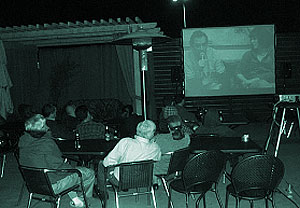 Photo Credit: Ask A ScientistI usually write about upcoming science events, but this time I'm flipping the script.
Photo Credit: Ask A ScientistI usually write about upcoming science events, but this time I'm flipping the script.
Let me tell you about my experience at last night's Ask a Scientist: How Computers Look at Art last night (December 3rd) at the Axis Café in San Francisco. Full disclosure - I run a science café, so consider me a fan. However, I was determined to just be one of the crowd last night.
KQED QUEST has covered science cafés before, including a history of the movement. On to my story... I arrived at Axis Café about 630 PM to an almost full house (~50 people). After ordering some food and a glass of wine at the bar, I hunkered down in a cozy chair. I people watched the youngish good looking crowd for a few minutes before overhearing a conversation in front of me. A couple of women mentioned it was there first time at a science café. To both, the format sounded cool, but both they couldn't convince friends to join them. We talked for a few minutes; mainly they said most were scared off because this seemed like a science class, definitely not for the average person. No matter how you frame it, science in café still sounds like a lecture to most. What followed was hardly a lecture.
David Stork grabbed a mic and launched into a discussion on the Vermeer painting "The Girl With the Pearl Earring." His research uses computer modeling to analyze light and shadows on paintings. After skipping the math, he showed the painting nearly perfectly displayed shadows if from one light source. This confirmed what many art historians wondered, there was a model for that famous painting who sat in Vermeer's studio. The speaker was definitely moving along pretty fast, but luckily there were lots of questions to slow him down.
Professor Stork continued on, showing how this technique could also identify fakes (i.e. the cover from a Star Magazine with Brad & Angelina). Most famously, this new technique has called into question the Hockney-Falco thesis on how renaissance artists drew their subjects (using a lens of sorts).
